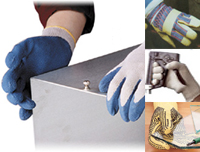| |
 |
|
 |
Special as it is, glove was not intended for practical
use in the beginning. However, it has become a must as
insulation material in cold regions, or for medical bact
eria-proof and industrial protective
articles in modern
times. The glove material can be categorized as
fiber,
leather, latex, etc. The style can be categorized as long,
short,
mitten and split finger. There are gloves which
only protect the back of the hand while exposing all the
fingers, as well as those protecting thewhole hand.
There are some delicate long gloves and lace gloves
which
are used for ceremony and decoration primarily. |
|
| |
|
|
|
Dyneema:
Dyneema was developed by DSM as a multipurpose high performance polyethylene fiber.
It has excellent abrasion and cut resistance, being up to 15 times stronger than steel
(weight for weight). It is cool to the touch and comfortable to wear and also launders well.
Spectra:
Spectra was developed by Honeywell Corporation. It is a high performance polyethylene
with many industrial and defense related applications, including cut resistant gloves for the
food industry.
Polyamide fiber:
It is commonly known as nylon, being durable in pulling and wear-resistant, flexible and
resilient. It can resume to its original shape after pulling. It is washable, quick-drying, low
water absorption and pest resistant.
Polyester fiber:
It is a synthetic material generated from the polymerization of petrochemical products. It is
flexible and washable with high toughness. In addition, polyester fiber can be mixed with
wool and cotton to overcome the disadvantage of non-absorbent polyester.
Cotton fiber:
Cotton has been in use since the ancient times. It is a natural, breathable, sweat-absorbent
and non-allergic fiber with good touch.
Leather material
Cow:
By far, the most commonly used leather in the safety industry due to good abrasion
resistance
and attractive appearance.
Grain Cowhide:
The exterior layer of the animal. Soft, flexible, and very durable.
Split Cowhide:
The layer beneath the surface of the cow.
Pig:
Pigskin is more breathable and supple than cowhide because of sweat pores on the
surface of the leather. Pigskin offers the best abrasion resistance for longer wear. The
naturally high lanolin content in pigskin allows it to return to softness, even after repeated
contact with water.
Goat:
Excellent abrasion resistance with strong tensile strength. High lanolin content makes the
leather soft.
Deer:
Highest tensile strength of all leathers. Excellent dexterity and softness.
Coating material
Nitrile (NBR) :
Nitrile can be applied to knit and cut-and-sewn gloves using several methods, including
screen printing, foam coating and dipping. It offers good mechanical properties (resistance to
abrasion, cuts, tears and punctures) and yet is soft and flexible so that gloves do not feel stiff.
Grip is also good and can be enhanced further by air-infusing (foaming) the nitrile during
dipping.This creates an open surface texture and greater surface area which improves grip
on wet or oily objects. Nitrile is also a good choice in high heat applications because it does
not melt at high temperatures, which could create product contamination issues (for example,
in an application such as auto-glass manufacture).
Polyurethane (PU) :
Polyurethane is the toughest of the popular coating polymers, with the best resistance to
abrasion, cuts, tears and punctures. This makes it highly suitablefor cut resistant gloves,
where its mechanical properties compliment those of the high performance fibers used in
those kinds of gloves. Also, because it’s tough, coatings can be made thinner than with other
polymers, yet still provide comparable levels of protection. This makes it a good choice for
applications such as fine assembly work where a high level of tactility (feel) is important.
Bi-Polymer :
Bi-Polymer is a blend of nitrile and polyurethane. It combines the bestproperties of both
polymers, offering great mechanical performance against abrasion, cuts, tears and punctures
as well as a high level of grip and a soft, flexible feel.
Poly Vinyl Chloride (PVC) :
PVC has been a popular choice for inexpensive dipped supported gloves for decades. In
more recent years it has emerged as an attractive option for palm coated dipped gloves.
Applied as an air infused (foamed) coating, it offers exceptional wet and dry grip as well as
mechanical properties that rival nitrile and polyurethane.
Latex :
Latex has very high elasticity and outstanding grip compared to other glove materials, and
withstands extreme temperature and tear resistance. Chemically, it resists alcohols, and
some ketones, but performs poorly around most hydrocarbon and organic solvents (ie.
gasoline). However, because of allergy issues, it is not always an option for some workers. |
|




